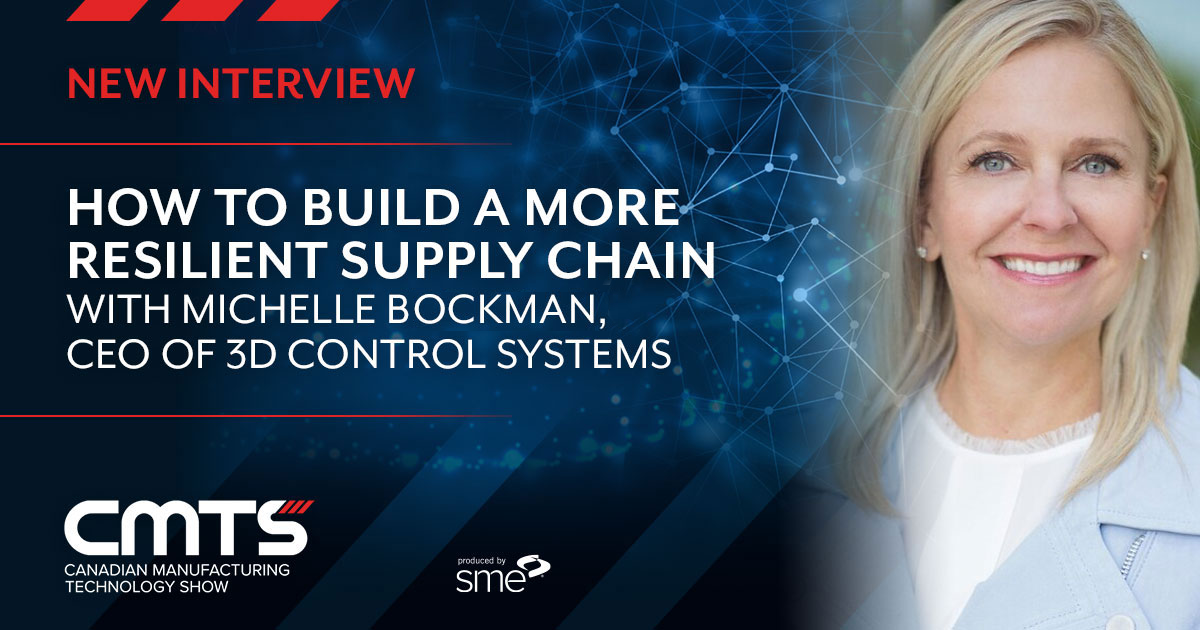
At CMTS 2021, we’ll showcase how 3D printing is a vital tool for mitigating supply chain disruptions
Manufacturers have experienced unprecedented supply chain disruptions due to COVID-19. Additive manufacturing (a.k.a. industrial 3D printing) is a game-changing technology that can help manufacturers build more resilient supply chains.
At the Canadian Manufacturing Technology Show (CMTS), Oct. 4-7 in Toronto, a panel of experts will discuss 3D printing as one of several tools that can help build more resilient systems and avoid the types of supply chain disruptions we’ve seen during COVID-19.
We spoke with keynote panelist Michelle Bockman, CEO of 3D Control Systems, for a preview of what to expect from the discussion, and where 3D printing might fit within a larger solution.
Q: What are the components of a resilient supply chain, as you see it?
The way I see it is, making sure that you have suppliers who are healthy enough to not go under. And also, the movement to decentralize manufacturing is here.
Yes, you might be a global company. But when it comes to delivery of your product, you really want to have that local presence. What's interesting that we saw in COVID is that the supply chain got totally disrupted.
With 3D printing, the beauty of it is that you can have it local. There are networks of 3D printers everywhere. I think 3D printing solves a lot of potential supply chain issues.
Q: Do you think it's inevitable that we're going to see widespread adoption of these kinds of technologies?
I think so. We thought the adoption of 3D printing was going to go a lot faster, but the technology's not quite there to say 3D printing is going to compete against injection molding or CNC.
It's really around quality and price. Do you have the repeatability and the accuracy that you need? And then speed and strength. You've got to figure out, can it meet the stress and strain requirements. Cost is the other area we need to tackle — just getting that cost down to be able to compete.
Q: Do you think it's inevitable that every company will have an additive manufacturing operation? Or are we going to see 3D printing hubs?
I think we're going to see both. We are seeing both today, and I think that that's going to continue to grow.
Q: Can we talk a bit about your company, and how it benefits manufacturers?
Sure. Our company has always been 3D Control Systems, but people used to know us as 3DPrinterOS, because that's our product name.
I could see that our platform was one that the industrial market needed.
It's basically the digital thread that goes from design to delivery. So it connects the design software, it connects for quoting and any kind of slicing, or build prep, and then afterwards with post processing and QA [quality assurance].
It's really moving from an analog world to a digital world. It's about optimizing the process. Our platform takes out a lot of the manual work.
Q: How much potential do you see in advanced manufacturing for this type of technology?
Well, people say it's a $12 trillion market. You know, I like that number. I'm hopeful that’s really the number. There's definitely a good market out there for software and for 3D printing in general.
Q: What prompted you to come to CMTS this year?
I know there's a lot of companies in Canada that are driving the adoption of 3D printing. From my past experience working in the Canadian market, there's a lot of opportunity there for us to help customers, so I'm excited to go.
Q: What do you hope people who attend the panel discussion will take away from it?
I think what it comes down to is what's going on in the market, and what the next steps are in the short term.
How do I get from point A to point B — not point A to point Z — and those steps in between.
And so that's what I really hope for — that realistic discussion about what's happening, and how to protect your supply chain, and how 3D printing can be a factor in supply chain management, especially when it comes to risk mitigation, as we saw with COVID.
This interview has been edited for clarity and length.
